Caecilians: The other amphibian
Legless creatures live secretive, strange existences underground and underwater
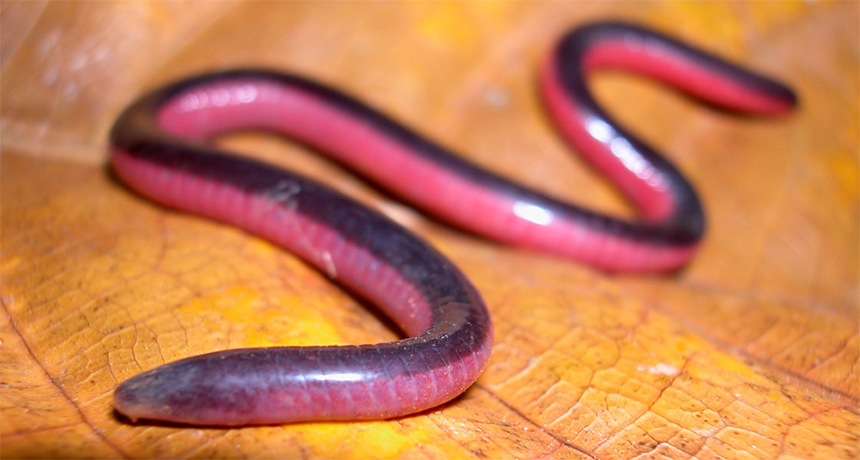
Caecilians may look like snakes or worms, but they are neither. They’re amphibians, which means the curious creatures’ closest relatives are frogs and salamanders.
John Measey
By Roberta Kwok
John Measey flew to Venezuela in 1997 in search of peculiar amphibians that looked like snakes or worms and lived underground. Measey’s team trekked through the rainforest, flipping over logs and digging into soil. After a few weeks, they still hadn’t found a single one.
Since some of these legless animals, known as caecilians (seh-CEE-lee-enz), also live in water, Measey travelled to a small fishing village at the edge of a large, bright-green lake. The villagers had set up toilets on piers over the lake, and they told Measey that they had seen animals that looked like eels when they went to the bathroom. So Measey jumped into the lake.
“We were absolutely excited,” he says. Measey is an evolutionary biologist — a scientist who studies the way living creatures have changed over long periods of time — now at Nelson Mandela Metropolitan University in Port Elizabeth, South Africa. “I had no problem jumping into the pea-green lake.” Sure enough, he found caecilians wriggling between stones in a wall at the lake’s edge.
Caecilians belong to the same group of animals that includes frogs and salamanders. But unlike other amphibians, caecilians lack legs. Some caecilians are as short as a pencil, while others grow as long as a child. Their eyes are tiny and hidden beneath skin and sometimes bone. And they have a pair of tentacles on their face that can sniff out chemicals in the environment.
“The whole creature is really quite bizarre,” says Emma Sherratt, an evolutionary biologist at Harvard University.
Not a snake, not a worm
Scientists first started studying caecilians in the 1700s. At first, some researchers thought the animals were snakes. But caecilians are very different. Snakes have scales on the outside of their body, while caecilian skin is made up of ring-shaped folds encircling the body. These folds often have scales embedded in them. Most caecilians do not have a tail; snakes do. Caecilians differ from their other lookalike, worms, in part because they possess a backbone and a skull.
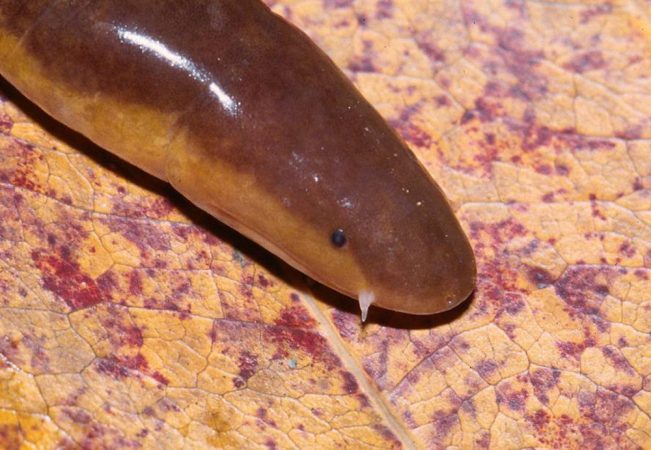
Biologists know very little about these creatures, compared with other animals. Because most caecilians burrow underground, they can be hard to find. They live in wet, tropical areas such as Central and South America, Africa, India and Southeast Asia — regions where until recently there weren’t many biologists. When local people do see caecilians, they often mistake them for snakes or worms.
“This is a major group of living creatures, and so few people even know they exist,” says Sherratt. “It’s just got this mistaken identity.”
Scientists now believe that caecilians, frogs and salamanders all evolved, or slowly changed over a long period of time, from a group of animals that lived more than 275 million years ago. These ancient animals probably looked more like a salamander, a small, four-legged creature with a tail. Biologists suspect those salamander-like ancestors might have started burrowing in leaf piles and eventually into the soil to hide from predators or to search for new sources of food.
As these animals spent more time underground, they evolved to become better burrowers. Over time, their legs disappeared and their bodies lengthened. Their skulls became very strong and thick, allowing the animals to ram their heads through the soil. They didn’t need to see much anymore, so their eyes shrank. A layer of skin or bone also grew over the eyes to protect them from dirt. And the creatures formed tentacles that could sense chemicals, helping the animals find prey in the dark.
Expert excavators
Caecilians are now superb burrowers. Jim O’Reilly, an evolutionary biologist at the University of Chicago, and his colleagues wanted to find out how hard caecilians could push against soil. In the lab, the team set up an artificial tunnel. They filled one end with dirt and put a brick at that end to stop the animal from burrowing any farther. To measure how hard the caecilian pushed, the scientists attached a device called a force plate to the tunnel.
A 50- to 60-centimeter-long (roughly 1.5- to 2-foot-long) caecilian proved much stronger than O’Reilly had expected. “It just shoved this brick off the table,” he recalls. The scientists performed the same experiment with similar-sized mud snakes and burrowing boas. The caecilians could push about twice as hard as both types of snakes, the researchers found.
The secret to caecilians’ strength may be a coiled set of tissues called tendons.
These tendons look like two intertwined Slinkies inside the animal’s body. As a burrowing caecilian holds its breath and contracts — or flexes — its muscles, the tendons stretch out as if something is pulling the Slinkies. The caecilian’s body becomes a little longer and thinner, pushing the skull forward. Worms move in a similar way, but they use muscles circling their body and extending lengthwise instead of spiraling tendons. To pull up the rest of its body, the caecilian relaxes the muscles in its body wall and scrunches up its backbone. This causes the body to become a little shorter and fatter.
After multiple cycles of the head burrowing forward and the body catching up, the caecilian may come to rest. At this point, it may exhale, its body going limp.
Caecilians have also come up with clever ways to capture their prey. To study the amphibian’s hunting techniques, Measey’s team filled an aquarium with soil and let 21- to 24-centimeter-long caecilians burrow tunnels. The team added earthworms and crickets, which caecilians like to eat. Because the aquarium was very thin, almost like a picture frame, the researchers could film what was happening in the burrows.
After an earthworm burrowed into a caecilian’s tunnel, the caecilian grabbed the earthworm with its teeth and started spinning around like a rolling pin. This spinning pulled the whole worm into the caecilian’s burrow and might have even made the worm dizzy. Measey thinks this trick might also give caecilians a better idea of how heavy their prey is. “If it’s a rat’s tail, you may just want to let go,” he says.
Dining on skin
Baby caecilians may have the oddest behavior of all. Some caecilians lay eggs in an underground chamber. After the eggs hatch, the young remain with their mother for about four to six weeks. Until recently, scientists weren’t sure how the mother fed her offspring.
Alex Kupfer, a zoologist now at the University of Potsdam in Germany, investigated. He travelled to Kenya to collect female caecilians and their eggs or babies from underground burrows. Then he put the animals in boxes and watched.
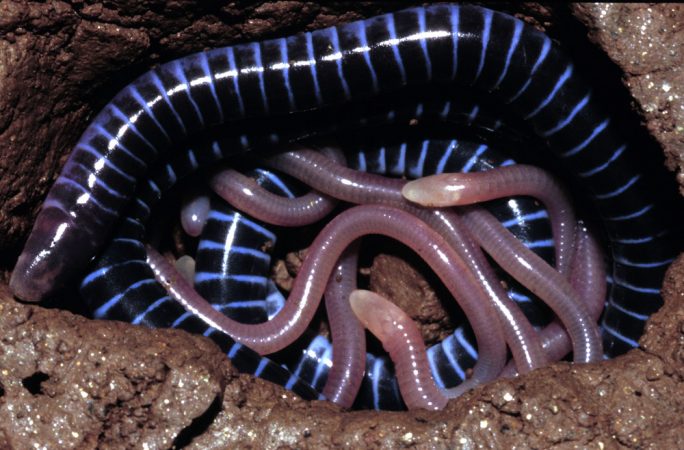
Most of the time, babies lay quietly with their mother. But once in awhile, the young caecilians started crawling all over her, tearing off pieces of her skin and eating it. “I thought, ‘Wow, cool,’” says Kupfer. “There’s no other behavior in the animal kingdom I can compare with this.” The mother isn’t hurt because her outer layer of skin is already dead, he says.
Kupfer’s team looked at pieces of the mother’s skin under a microscope and saw that the cells were unusually big. The cells also contained more fat than cells from female caecilians that weren’t raising young. So the skin probably gives babies a lot of energy and nutrition. To rip off their mother’s skin, young caecilians use special teeth. Some are like scrapers, with two or three points; others are shaped like hooks.
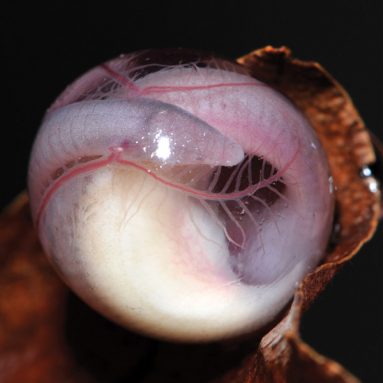
Kupfer thinks his team’s findings may reveal one step in the animals’ evolution. Ancient caecilians probably laid eggs but didn’t take care of their young. Today, some species of caecilians don’t lay eggs at all. Instead, they give birth to live young. These babies grow inside a tube in the mother’s body, called an oviduct, and use their teeth to scrape the lining of the tube for nutrition. The caecilians that Kupfer studied appear somewhere in between: They still lay eggs, but the babies dine on their mother’s skin instead of her oviduct.
More secrets and surprises
Scientists still have a lot of questions about caecilians. Researchers have little idea how long most species live, how old the females are when they first give birth and how often they have babies. And biologists have yet to discover how frequently caecilians fight and whether they travel much or spend life largely in one place.
As scientists learn more about caecilians, surprises often emerge. In the 1990s, researchers discovered that a dead specimen of a large, water-dwelling caecilian had no lungs. It probably breathed in all of the air it needed through its skin. So scientists thought this species might inhabit cold, fast-flowing mountain streams, where the water contains more oxygen. But last year, these lungless caecilians were found alive in a completely different place: warm, low-lying rivers in the Brazilian Amazon. Somehow this caecilian species still gets enough oxygen, perhaps because parts of the river flow so fast.
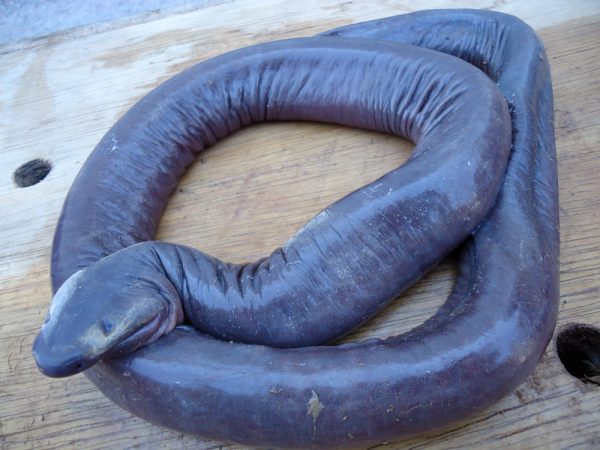
Scientists have identified at least 185 different species of caecilians. And there may be more. In February 2012, a team led by researchers at the University of Delhi in India announced they had discovered a new type of caecilian, which includes several species. These amphibians from northeastern India live underground, vary in color from light gray to purple and can grow more than a meter (almost 4 feet) long.
Not knowing much about caecilians makes it hard to determine whether their species are surviving comfortably or in peril. And that’s important, because throughout the past two decades, many amphibian populations have begun to disappear. Some species have gone extinct. Threats include disappearing habitat, other species invading the amphibians’ homes and a fungus that causes a killer disease. But researchers aren’t sure how many caecilian species might be similarly threatened because they don’t know how many of these animals existed to begin with. Biologists will need to monitor caecilians more carefully to find out whether populations of their species are declining — and if so, where.
It’s unlikely that any wild caecilians live in the United States or Canada. But in tropical areas, scientists can learn a lot about them if they look hard enough. “Caecilians are there,” says Sherratt. “They just need more people to start digging for them.”
Power Words
amphibians A group of animals that includes frogs, salamanders and caecilians. Amphibians have backbones and can breathe through their skin. Unlike reptiles, birds and mammals, unborn or unhatched amphibians do not develop in a special protective sac called an amniotic sac.
caecilian A type of amphibian that has no legs. Caecilians have ring-shaped folds of skin called annuli, small eyes covered by skin and sometimes bone, and a pair of tentacles. Most of them live underground in the soil, but some spend their entire lives in water.
tendon A tissue in the body that connects muscle and bone.
oviduct A tube found in female animals. The female’s eggs pass through the tube or stay in the tube and develop into young animals.
evolve Gradually change from one generation to the next.
contract To activate muscle by allowing filaments in the muscle cells to connect. The muscle becomes more rigid as a result.







